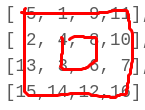描述
You are given an n x n 2D matrix representing an image.
Rotate the image by 90 degrees (clockwise).
Note:
You have to rotate the image in-place, which means you have to modify the input 2D matrix directly. DO NOT allocate another 2D matrix and do the rotation.
Example 1:
Given input matrix = [ [1,2,3], [4,5,6], [7,8,9] ], rotate the input matrix in-place such that it becomes: [ [7,4,1], [8,5,2], [9,6,3] ]
Example 2:
Given input matrix = [ [ 5, 1, 9,11], [ 2, 4, 8,10], [13, 3, 6, 7], [15,14,12,16] ], rotate the input matrix in-place such that it becomes: [ [15,13, 2, 5], [14, 3, 4, 1], [12, 6, 8, 9], [16, 7,10,11] ]
思路:移位法
将矩阵的的边框连线

如果矩阵的宽度和高度都为n,那么一共有n/2个连线框,这些连线框位移形成旋转矩阵,如下图

按顺时针位移,依次遍历连线上的点就行。
这里为了不增加额外的空间消耗,不创建新的矩阵,我们用一个temp变量,存放临时的待替换元素,如果要顺时针替换,则需要两个临时变量还要不断更新,所以我们采用逆时针旋转替换,这样只需要在开始的时候加入一个temp变量即可。
然后遍历的时候令i为旋转的圈数,j为直线上遍历的序号。使得j=i,j增大到n-1-i,然后根据四个点的序号关联完成转移。
class Solution { public: void rotate(vector<vector<int>>& matrix) { int n = matrix.size(); int count = n/2,temp = 0; for(int i = 0;i < count;++i){ for(int j = i;j<n-i-1;++j){ temp = matrix[i][j]; matrix[i][j] = matrix[n - j - 1][i]; matrix[n - j - 1][i] = matrix[n - i - 1][n - j - 1]; matrix[n - i - 1][n - j - 1] = matrix[j][n - i - 1]; matrix[j][n - i - 1] = temp; } } } };